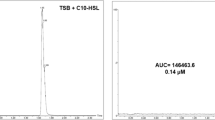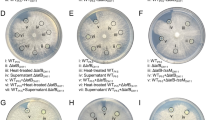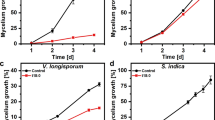Abstract
N-acylhomoserine lactones (AHLs) play a critical role in plant/microbe interactions. The AHL, N-(3-oxohexanoyl)-L-homoserine lactone (OHHL), induces exoenzymes that degrade the plant cell wall by the pathogenic bacterium Erwinia carotovora. Conversely, the antifungal activity of the biocontrol bacterium Pseudomonas aureofaciens 30–84 is due (at least in part) to phenazine antibiotics whose synthesis is regulated by N-hexanoylhomoserine lactone (HHL). Targeting the product of an AHL synthase gene (yenI) from Yersinia enterocolitica to the chloroplasts of transgenic tobacco plants caused the synthesis in plants of the cognate AHL signaling molecules (OHHL and HHL). The AHLs produced by the transgenic plants were sufficient to induce target gene expression in several recombinant bacterial AHL biosensors and to restore biocontrol activity to an HHL-deficient P. aureofaciens strain. In addition, pathogenicity was restored to an E. carotovora strain rendered avirulent as a consequence of a mutation in the OHHL synthase gene, carI. The ability to generate bacterial quorum-sensing signaling molecules in the plant offers novel opportunities for disease control and for manipulating plant/microbe interactions.
This is a preview of subscription content, access via your institution
Access options
Subscribe to this journal
Receive 12 print issues and online access
$209.00 per year
only $17.42 per issue
Buy this article
- Purchase on Springer Link
- Instant access to full article PDF
Prices may be subject to local taxes which are calculated during checkout



Similar content being viewed by others
References
Fuqua, W.C., Winans, S.C. & Greenberg, E.P. Quorum sensing in bacteria: the LuxR-LuxI family of cell density responsive transcriptional regulators. J. Bacteriol. 176, 269–275 ( 1994).
Salmond, G.P.C., Bycroft, B.W., Stewart, G.S.A.B. & Williams, P. The bacterial enigma: cracking the code of cell-cell communication. Mol. Microbiol. 16, 615–624 (1995).
Swift, S., Throup, J.P., Williams, P., Salmond, G.P.C. & Stewart, G.S.A.B. Quorum sensing: a population-density component in the determination of bacterial phenotype. Trends in Biological Science 21, 214–219 (1996).
Swift, S. et al. A novel strategy for the isolation of luxI homologues: evidence for the widespread distribution of a LuxR:LuxI superfamily in enteric bacteria. Mol. Microbiol. 10, 511– 520 (1993).
Bainton, N.J. et al. N-(3-oxohexanoyl)-L-homoserine lactone regulates carbapenem antibiotic production in Erwinia carotovora. Biochem. J. 288, 997–1004 (1992).
Jones, S. et al. The lux autoinducer regulates the production of exoenzyme virulence determinants in Erwinia carotovora and Pseudomonas aeruginosa. EMBO J. 12, 2477–2482 (1993).
McGowan, S.J. et al. Analysis of bacterial carbapenem antibiotic production genes reveals a novel β-lactam biosynthesis pathway. Mol. Microbiol. 22, 415–426 (1996).
McClean, K.H. et al. Quorum sensing and Chromobacterium violaceum: exploitation of violacein production and inhibition for the detection of N-acylhomoserine lactones. Microbiology 143, 3703– 3711 (1997).
Cherenin, L.S. et al. Chitinolytic activity in Chromobacterium violaceum: substrate analysis and regulation by quorum sensing. J. Bacteriol. 180 4435–4441 (1998).
Wood, D.W. & Pierson, L.S. The phzI gene of Pseudomonas aureofaciens 30–84 is responsible for the production of a diffusible signal required for phenazine antibiotic production. Gene 168, 49–53 (1996).
Wood, D.W., Gong, F.C., Daykin, M.M., Williams, P. & Pierson, L.S. N-acyl-homoserine lactone-mediated regulation of phenazine gene expression by Pseudomonas aureofaciens 30–84 in the wheat rhizosphere. J. Bacteriol 179, 7663–7670 (1997).
Throup, J.P. et al. Characterization of the YenI/YenR locus from Yersinia enterocolitica mediating the synthesis of 2 N-acylhomoserine lactone signal molecules. Mol. Microbiol. 17, 345– 356 (1995).
More, M.L. et al. Enzymatic synthesis of a quorum-sensing autoinducer through use of defined substrates. Science 272, 1655– 1658 (1996).
Val, D.E. & Cronan, J.E. Jr. In vivo evidence that S-adenosylmethionine and fatty acid synthesis intermediates are the substrates for the LuxI family of autoinducer synthases. J. Bacteriol. 180, 2644–2651 (1998).
Jiang, Y. et al. In vitro biosynthesis of the Pseudomonas aeruginosa quorum sensing signal molecule, N-butanoyl-L-homoserine lactone. Mol. Microbiol. 28, 193–203 (1998).
Winson, M.K. et al. Construction and analysis of luxCDABE-based plasmid sensors for investigating N-acyl homoserine lactone-mediated quorum sensing. FEMS Microbiol. Lett. 163, 185– 192 (1998).
Pirhonen, M., Flego, D., Heikineimo, R. & Palva, E.T. A small diffusible signal molecule is responsible for the global control of virulence and exoenzyme production in the plant pathogen Erwinia carotovora . EMBO J. 12, 2467– 2476 (1993).
Perombelon, M.C.M. & Kelman, A. Ecology of the soft rot erwinias. Annu. Rev. Phytopathol. 18, 361–387 (1980).
Palva, T.K., Hurtig, M., Saindrenan, P. & Palva E.T. Salicylic acid induced resistance to Erwinia carotovora subsp. carotovora in tobacco. Molecular Plant-Microbe Interactions 7, 356–363 ( 1994).
Gray, K.M., Pearson, J.P., Downie, J.A., Boboye, B.E.A. & Greenberg, E.P. Cell-to-cell signalling in the symbiotic nitrogen-fixing bacterium Rhizobium leguminosarum: autoinduction of a stationary phase and rhizosphere-expressed genes. J. Bacteriol. 178, 372–376 ( 1996).
Schripsema, J. et al. Bacteriocin small of Rhizobium leguminosarum belongs to the class of N-acyl-L-homoserine lactone molecules known as autoinducers and as quorum sensing co-transcriptional factors. J. Bacteriol. 178, 366–371 ( 1996).
Toyota, K. & Ikeda, K. Relative importance of motility and antibibiosis in the rhizoplane competence of a biocontrol agent Pseudomonas fluorescens MelRC2Rif. Biol. Fert. Soils 25, 416–420 (1997).
Becker, J.O. & Schwinn, F.J. Control of soil-borne pathogens with living bacteria and fungi—status and outlook. Pesticide Science 37, 355–363 ( 1993).
Shaw, P.D. et al. Detecting and characterizing N-acyl-homoserine lactone signal molecules by thin-layer chromatography. Proc. Natl. Acad. Sci. USA 94, 6036–6041 (1997).
Datla, R.S.S. et al. Improved high-level constitutive foreign gene expression in plants using an AMV RNA4 untranslated leader sequence. Plant Sci. 94, 139–149 (1993).
Pietrzak, M., Shillito, R.D., Hohn, T. & Potrykus, I. Expression in plants of two bacterial antibiotic resistance genes after protoplast transformation with a new plant expression vector. Nucleic Acids Res. 14, 5857–5868 (1986).
Bevan, M. Binary agrobacterium vectors for plant transformation. Nucleic Acids Res. 12, 8711–8721 (1984).
Dean, C. et al. Molecular characterization of the rbcS multi-gene family of petunia (Mitchell). Mol. Gen. Genet. 206, 465– 474 (1987).
Draper, J., Scott, R., & Hamil, J. in Plant genetic transformation and gene expression, a laboratory manual. (eds Draper J., Scott R., Armitage P. & Walden R) 69–160 (Blackwell Scientific Publications, London; 1988).
Camara, M., Daykin, M. & Chhabra, S.K. in Methods in microbiology: bacterial pathogenesis. Vol. 27 (eds Williams P.H., Salmond G. & Ketley J.) 319–330 Academic Press, London; 1998 ).
Acknowledgements
We thank Barrie Bycroft for helpful discusions, Siri Ram Chhabra for providing synthetic AHLs, and Sandy Pierson for the P. aureofaciens phzI mutant. This work was supported by a Biotechnology and Biological Sciences Research Council Sir David Phillips Fellowship awarded to R.G.F. and by grants from the Biotechnology and Biological Sciences Research Council and the Wellcome Trust to D.G., P.W., and G.S.A.B.S., which are gratefully acknowledged.
Author information
Authors and Affiliations
Corresponding author
Rights and permissions
About this article
Cite this article
Fray, R., Throup, J., Daykin, M. et al. Plants genetically modified to produce N-acylhomoserine lactones communicate with bacteria. Nat Biotechnol 17, 1017–1020 (1999). https://doi.org/10.1038/13717
Received:
Accepted:
Issue Date:
DOI: https://doi.org/10.1038/13717
This article is cited by
-
The acyl-homoserine lactone (AHL)-type quorum sensing system affects growth rate, swimming motility and virulence in Acidovorax avenae subsp. citrulli
World Journal of Microbiology and Biotechnology (2011)
-
High yield expression of an AHL-lactonase from Bacillus sp. B546 in Pichia pastoris and its application to reduce Aeromonas hydrophila mortality in aquaculture
Microbial Cell Factories (2010)
-
Acyl-homoserine lactone-mediated cross talk among epiphytic bacteria modulates behavior of Pseudomonas syringae on leaves
The ISME Journal (2009)



